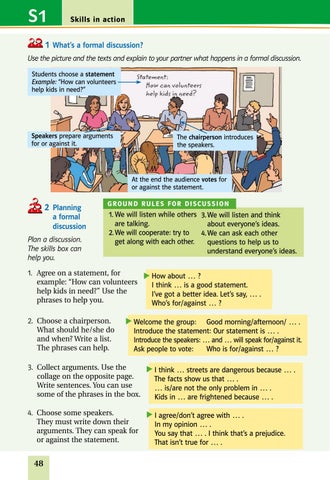S1
Skills in action
1 What’s a formal discussion? Use the picture and the texts and explain to your partner what happens in a formal discussion. Students choose a statement Example: “How can volunteers help kids in need?”
Speakers prepare arguments for or against it.
The chairperson introduces the speakers.
At the end the audience votes for or against the statement.
2 Planning
a formal discussion
Plan a discussion. The skills box can help you.
G r o u n d rules f o r d iscussi o n
1. We will listen while others 3. We will listen and think are talking. about everyone’s ideas. 2. We will cooperate: try to 4. We can ask each other get along with each other. questions to help us to understand everyone’s ideas.
1. Agree on a statement, for example: “How can volunteers help kids in need?” Use the phrases to help you. 2. Choose a chairperson. What should he/she do and when? Write a list. The phrases can help.
How about … ? I think … is a good statement. I’ve got a better idea. Let’s say, … . Who’s for/against … ?
Welcome the group: Good morning/afternoon/ … . Introduce the statement: Our statement is … . Introduce the speakers: … and … will speak for/against it. Ask people to vote: Who is for/against … ?
3. Collect arguments. Use the collage on the opposite page. Write sentences. You can use some of the phrases in the box.
I think … streets are dangerous because … . The facts show us that … . … is/are not the only problem in … . Kids in … are frightened because … .
4. Choose some speakers. They must write down their arguments. They can speak for or against the statement.
I agree/don’t agree with … . In my opinion … . You say that … . I think that’s a prejudice. That isn’t true for … .
48












































